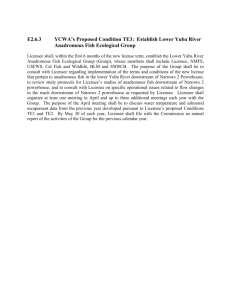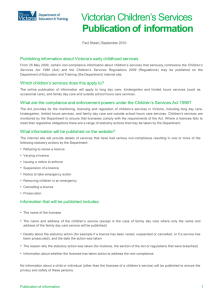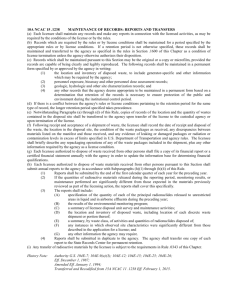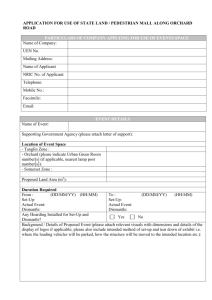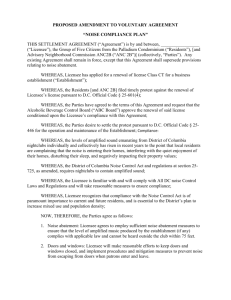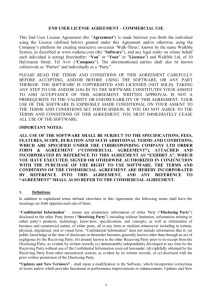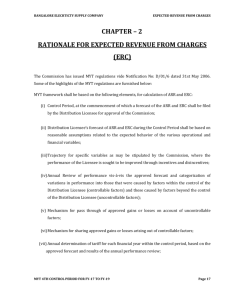united states of america 113 ferc ¶ 62, 155
advertisement
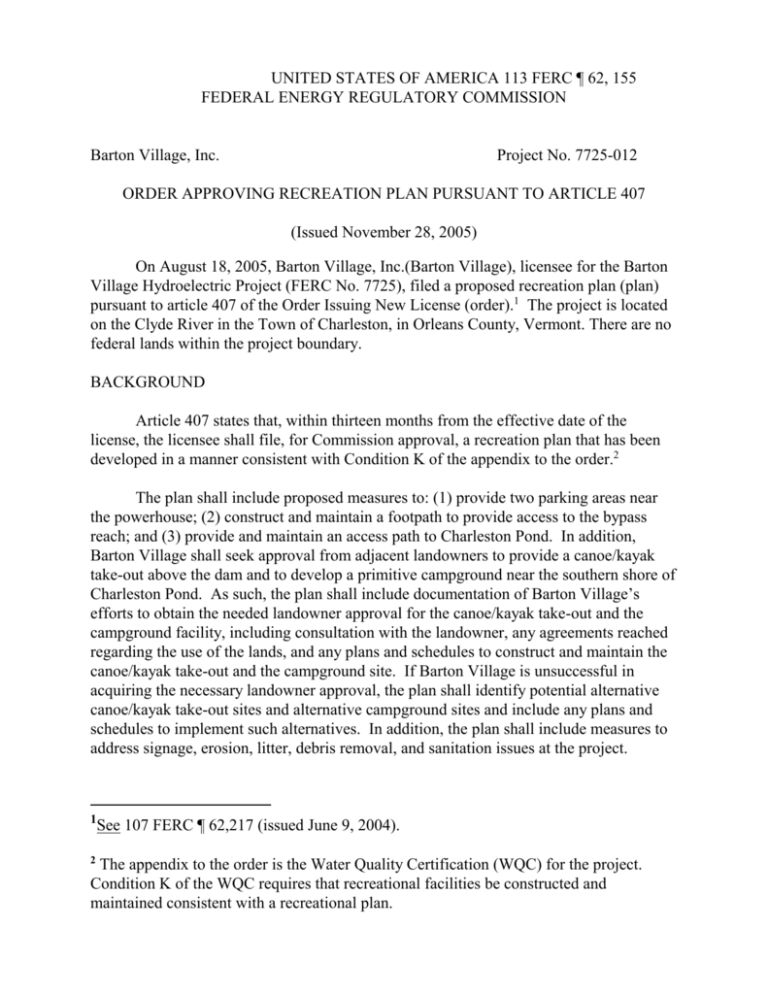
UNITED STATES OF AMERICA 113 FERC ¶ 62, 155 FEDERAL ENERGY REGULATORY COMMISSION Barton Village, Inc. Project No. 7725-012 ORDER APPROVING RECREATION PLAN PURSUANT TO ARTICLE 407 (Issued November 28, 2005) On August 18, 2005, Barton Village, Inc.(Barton Village), licensee for the Barton Village Hydroelectric Project (FERC No. 7725), filed a proposed recreation plan (plan) pursuant to article 407 of the Order Issuing New License (order).1 The project is located on the Clyde River in the Town of Charleston, in Orleans County, Vermont. There are no federal lands within the project boundary. BACKGROUND Article 407 states that, within thirteen months from the effective date of the license, the licensee shall file, for Commission approval, a recreation plan that has been developed in a manner consistent with Condition K of the appendix to the order.2 The plan shall include proposed measures to: (1) provide two parking areas near the powerhouse; (2) construct and maintain a footpath to provide access to the bypass reach; and (3) provide and maintain an access path to Charleston Pond. In addition, Barton Village shall seek approval from adjacent landowners to provide a canoe/kayak take-out above the dam and to develop a primitive campground near the southern shore of Charleston Pond. As such, the plan shall include documentation of Barton Village’s efforts to obtain the needed landowner approval for the canoe/kayak take-out and the campground facility, including consultation with the landowner, any agreements reached regarding the use of the lands, and any plans and schedules to construct and maintain the canoe/kayak take-out and the campground site. If Barton Village is unsuccessful in acquiring the necessary landowner approval, the plan shall identify potential alternative canoe/kayak take-out sites and alternative campground sites and include any plans and schedules to implement such alternatives. In addition, the plan shall include measures to address signage, erosion, litter, debris removal, and sanitation issues at the project. 1 2 See 107 FERC ¶ 62,217 (issued June 9, 2004). The appendix to the order is the Water Quality Certification (WQC) for the project. Condition K of the WQC requires that recreational facilities be constructed and maintained consistent with a recreational plan. Project No. 7725-012 -2- The plan shall also include, at a minimum, the following information: (1) a detailed plan and schedule for implementing the proposed measures; (2) a description of how the needs of individuals with disabilities were considered in the design and construction of any new facilities; and (3) appropriate maps and drawings showing the type and location of the proposed measures in relation to the project’s existing recreation facilities and the project boundary. The licensee shall prepare the plan after consultation with the Vermont Agency of Natural Resources (VANR) and the U.S. Fish and Wildlife Service (FWS). In addition, the licensee shall include with the plan documentation of consultation with VANR and FWS, copies of comments and recommendations on the completed plan after it has been prepared and provided to the agencies, and specific descriptions of how the agencies' comments are accommodated by the plan. The licensee shall allow a minimum of 30 days for the agencies to comment and to make recommendations. If the licensee does not adopt a recommendation, the filing shall include the licensee's reasons, based on projectspecific information. The Commission reserves the right to require changes to the plan. No landclearing or ground-disturbing activities associated with the recreation plan shall begin until the licensee is notified that the plan is approved. The plan shall not be implemented until the licensee is notified that the plan is approved. Upon Commission approval, the licensee shall implement the plan, including any changes required by the Commission. PROPOSED PLAN The proposed plan outlines those measures that the licensee plans to implement to comply with article 407, specifically implementing proposed measures for two parking areas near the powerhouse, a footpath to afford access to the bypass reach, and an access path to Charleston Pond. In addition, the licensee proposes to work with other entities to seek approval from adjacent landowners for a canoe/kayak take-out above the dam and a primitive campsite near the southern shore of Charleston Pond. Signage requirements are discussed within the appropriate sections of the plan. Parking Areas The licensee reports that currently there is a parking area located at the end of Great Falls Road, which serves as the access road to the powerhouse and associated project facilities. Both Great Falls Road and the parking area are gravel surfaced. The town of Charleston maintains Great Falls Road. Project No. 7725-012 -3- As required in license article 407, the licensee would designate two locations in this area for parking by recreationists and other visitors. These areas would be: (1) located adjacent to the easterly and northerly sides of the diesel generating building; (2) able to accommodate approximately five automobiles; and (3) marked with signage that reads “Visitor Parking.” In addition, a map showing the general layout of the project and associated recreation facilities would be posted near the parking area, as well as a short narrative describing appropriate use of each facility. Footpath to Bypass Reach To enhance access for angling and aesthetic viewing, as well as other recreational uses, the licensee would designate and maintain a footpath to the bypass reach as required by license article 407. The proposed path would lead from the parking area to the lower portion of the bypass reach approximately 125 feet below the waterfall. The path would be generally located on the southerly side of the diesel generating station and the project powerhouse. Construction and maintenance activities would consist of clearing grassy and woody vegetation. Maintenance would also include monitoring for significant erosion and implementing appropriate remedial actions, if necessary. The path would be marked with directional arrow signs. The licensee would be responsible for these activities. Access Path to Charleston Pond To provide access for angling and launching carry-in boats, the licensee would maintain an access path to the southern shoreline area of Charleston Pond. The access path would lead from the parking area at the end of Great Falls Road to Charleston Pond. This path would also act as a segment of a portage route. Construction as well as future operations and maintenance activities would consist of clearing grassy and woody vegetation. Maintenance would also include monitoring for significant erosion and implementing appropriate remedial actions, if necessary. The path would be cleared to a suitable width and height, so as to provide access by users carrying watercraft. The path also would be marked with directional-arrow signs. The licensee would be responsible for these activities. Project No. 7725-012 -4- Canoe Portage The licensee is assisting the Northern Forest Canoe Trail Association (NFCT Association) to formalize a canoe portage around the project. The NFCT is a 740-mile water trail that follows Native American travel routes from Old Forge, New York, across Vermont, Québec and New Hampshire, to Fort Kent, Maine. Volunteers have been working to reestablish the NFCT in its entirely with the addition of campsites, portage routes, trail signs, and access points. The NFCT encompasses a portion of the Clyde River. The NFCT Association has established a canoe/kayak take-out location above the dam on the upstream side (river left) of the Route 105 Bridge. From this location, a portage route continues along Great Falls Road for approximately 1,300 feet. Portage then continues along the previously mentioned access to Charleston Pond. The licensee does not own the properties where the canoe/kayak take-out and putin would be located. The NFCT Association has reached verbal agreements with landowners and the Vermont Agency of Transportation for use of these areas. In the event these agreements are terminated by any of the parties during the license term, the licensee would identify alternative locations for these canoe portage facilities. Construction and maintenance activities would consist of clearing grassy and woody vegetation. Maintenance would also include monitoring for significant erosion and implementing appropriate remedial actions, if necessary. The NFCT Association and the licensee would work cooperatively to conduct periodic litter clean-up, as well as maintenance related to the canoe portage. The NFCT Association would post signage delineating the canoe take-out and put-in locations, as well as directional-arrow signs along the portage route. Primitive Campsite The licensee assisted the NFCT Association with development of a primitive campsite near the southern shore of Charleston Pond. The site provides a stop-over point for canoeists and kayakers navigating either locally or regionally along the NFCT. The site is available to other recreationists as well. Access to the campsite would be provided through the aforementioned access path to Charleston Pond. However the licensee does not own the land where the campsite is located. The NFCT Association has reached a verbal agreement with the landowner, Mr. Erik Biedermann, for development and use of the campsite. Project No. 7725-012 -5- Construction activities consisted of clearing grassy and woody vegetation to create a tent site and campfire pits. No formal sanitation facilities were developed; however, the sanitary conditions of the site would be monitored and remedial actions taken, if necessary. The NFCT Association and the licensee would work cooperatively to conduct periodic litter clean-up at the site, as well as maintenance. ADA Accessible Facilities The access paths to the bypass reach and Charleston Pond were evaluated for their potential to provide enhanced access to individuals with disabilities. Due to the relatively steep terrain associated with these areas, it is not feasible to provide wheelchair access for disabled persons. Furthermore, disturbance from constructing a trail of an acceptable slope to accommodate disabled persons has a high potential to cause erosion at these sites. Erosion and Sediment Control Ground-disturbing activities associated with the proposed recreation measures is expected to be minimal. In some instances, the posting of signs would involve digging holes for support posts. However, it is anticipated that no erosion issues would be encountered as a result of this activity. If significant ground-disturbing activities are planned on project lands in the future, the licensee would be responsible for acquiring all necessary state and local permits. Consistent with Condition L of the project’s WQC (see footnote 2), upon written request by VANR, the licensee would design and implement erosion control measures as necessary to address erosion occurring as a result of recreational use on project lands. Construction Schedule and Monitoring Construction of the canoe portage and primitive campsite has already been initiated as a cooperative effort among the NFCT Association, involved landowners, and the licensee. These facilities would be completed within 6 months of the Commission’s approval of the plan. Consistent with Condition K of the project’s WQC (see footnote 2), the plan would be reviewed and, if necessary, updated every six years. Project No. 7725-012 -6- AGENCY CONSULTATION In accordance with article 407, a draft of the plan was distributed to VANR and FWS for review. Comments were received from these agencies clarifying earlier concerns, comments, or recommendations. These comments were all addressed by the licensee in the plan. DISCUSSION The licensee’s proposed plan meets the requirements of license article 407. The proposed plan has been reviewed by state and federal resource agencies, as required. The plan would improve existing recreational uses and opportunities at the project, and would promote safe public boating in the project area. The plan should be approved. The Director orders: (A) The Recreation Plan, filed on August 18, 2005, pursuant to article 407 of the license, for the Barton Village Hydroelectric Project is approved. (B) This order constitutes final agency action. Requests for rehearing by the Commission may be filed within 30 days of the date of this order, pursuant to 18 C.F.R. §385.713. John E. Estep Division of Hydropower Administration and Compliance
